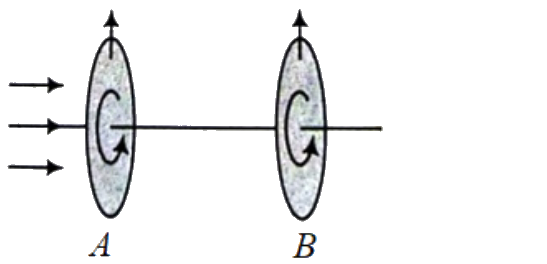Two polaroids are oriented with their planes perpendicular to incident light and transmission axis making an angle 45∘ with each other. Find the fraction of incident light which is transmitted.
To solve the problem of finding the fraction of incident light transmitted through two polaroids oriented at a 45-degree angle to each other, we can follow these steps:
1. Identify the Incident Light Intensity:
Let the intensity of the incident light be I0.
2. First Polarizer Effect:
When unpolarized light passes through the first polarizer, the intensity of the transmitted light is reduced to half. Therefore, the intensity after the first polarizer, I1, is given by:
I1=I02
3. Second Polarizer Effect:
The second polarizer is oriented at an angle of 45∘ to the first polarizer. According to Malus's Law, the intensity of light transmitted through a polarizer is given by:
I2=I1⋅cos2(θ)
where θ is the angle between the light's polarization direction and the polarizer's transmission axis.
4. Substituting Values:
Here, θ=45∘. Thus, we substitute I1 into the equation:
I2=(I02)⋅cos2(45∘)
5. Calculate cos2(45∘):
We know that:
cos(45∘)=1√2
Therefore:
cos2(45∘)=(1√2)2=12
6. Final Intensity Calculation:
Now, substituting cos2(45∘) back into the equation for I2:
I2=(I02)⋅12=I04
7. Finding the Fraction of Incident Light:
The fraction of the incident light transmitted through both polaroids is given by:
Fraction=I2I0=I04I0=14
8. Final Answer:
Therefore, the fraction of incident light transmitted through the two polaroids is:
14 or 25%
Let the intensity of the incident light be I0.
When unpolarized light passes through the first polarizer, the intensity of the transmitted light is reduced to half. Therefore, the intensity after the first polarizer, I1, is given by:
I1=I02
The second polarizer is oriented at an angle of 45∘ to the first polarizer. According to Malus's Law, the intensity of light transmitted through a polarizer is given by:
I2=I1⋅cos2(θ)
where θ is the angle between the light's polarization direction and the polarizer's transmission axis.
Here, θ=45∘. Thus, we substitute I1 into the equation:
I2=(I02)⋅cos2(45∘)
We know that:
cos(45∘)=1√2
Therefore:
cos2(45∘)=(1√2)2=12
Now, substituting cos2(45∘) back into the equation for I2:
I2=(I02)⋅12=I04
The fraction of the incident light transmitted through both polaroids is given by:
Fraction=I2I0=I04I0=14
Therefore, the fraction of incident light transmitted through the two polaroids is:
14 or 25%
Similar Questions
Two polaroid's are oriented with their planes perpendicular to incident light and transmission axis making an angle of 30∘ with each other. What fraction of incident unpolarized light transmitted?
View SolutionTwo polaroid's are oriented with their planes perpendicular to incident light and transmission axis making an angle of 30∘ with each other. What fraction of incident unpolarized light transmitted?
View SolutionAn unpolarised beam of intensity I0 is incident on a pair of nicols making an angle of 60∘ with each other. The intensity of light emerging from the pair is
View SolutionUnpolarised light of intensity I0 passes through five successive polaroid sheets,each of whose transmission axes makes an angle 45∘. With the previous one.The intensity of the finally transmitted light is
View SolutionA beam of natural light falls on a system of 5 polaroids, which are arranged in succession such that the pass axis of each polaroid is turned through 60∘ with respect to the preceding one. The fraction of the incident light intensity that passes through the system is :
View SolutionA clear sheet of polaroid is placed on the top of similar sheet so that their axes make an angle sin−1(35) with each other. The ratio of intensity of the emergent light to that of unpolarised incident light is
View SolutionThe incident ray and the reflected ray from a mirror are mutually perpendicular to each other.
Find the angle of incidence.View SolutionTwo polaroids are placed such that their planes are parallel to each other with their access of transmission at 30°. If an unpolarised light of intensity I0 is incident on first polaroid polarizer then intensity of light that will be transmitted through the second polaroid is
View SolutionTwo Nicols are oriented with their principal planes making an angle of 60∘. The percentage of incident unpolarised light which passes through the system is
View SolutionConsider two polaroids A and B as shown. Unpolarised right is incident on polaroid A. Now, both the polaroids are rotated simultaneoulsy by 180∘ in the same sense of rotation such that at energy instant, their pass (transmission) axes always remain parallel to each other. During the rotation, intensity of transmitted light through polaroid B
 View Solution
View Solution

